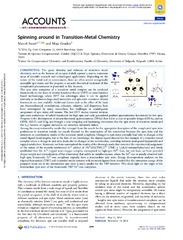Приказ основних података о документу
Spinning around in Transition-Metal Chemistry
| dc.creator | Swart, Marcel | |
| dc.creator | Gruden-Pavlović, Maja | |
| dc.date.accessioned | 2018-11-22T00:37:39Z | |
| dc.date.available | 2018-11-22T00:37:39Z | |
| dc.date.issued | 2016 | |
| dc.identifier.issn | 0001-4842 | |
| dc.identifier.uri | https://cherry.chem.bg.ac.rs/handle/123456789/2367 | |
| dc.description.abstract | CONSPECTUS: The great diversity and richness of transition metal chemistry, such as the features of an open d-shell, opened a way to numerous areas of scientific research and technological applications. Depending on the nature of the metal and its environment, there are often several energetically accessible spin states, and the progress in accurate theoretical treatment of this complicated phenomenon is presented in this Account. The spin state energetics of a transition metal complex can be predicted theoretically on the basis of density functional theory (DFT) or wave function based methodology, where DFT has advantages since it can be applied routinely to medium-to-large-sized molecules and spin-state consistent density functionals are now available. Additional factors such as the effect of the basis set, thermochemical contributions, solvation, relativity, and dispersion, have been investigated by many researchers, but challenges in unambiguous assignment of spin states still remain. The first DFT studies showed intrinsic spin-state preferences of hybrid functionals for high spin and early generalized gradient approximation functionals for low spin. Progress in the development of density functional approximations (DFAs) then led to a class of specially designed DFAs, such as OPBE, SSB-D, and S12g, and brought a very intriguing and fascinating observation that the spin states of transition metals and the S(N)2 barriers of organic molecules are somehow intimately linked. Among the many noteworthy results that emerged from the search for the appropriate description of the complicated spin state preferences in transition metals, we mainly focused on the examination of the connection between the spin state and the structures or coordination modes of the transition metal complexes. Changes in spin states normally lead only to changes in the metal ligand bond lengths, but to the best of our knowledge, the dapsox ligand showed the first example of a transition-metal complex where a change in spin state leads also to changes in the coordination, switching between pentagonal-bipyramidal and capped-octahedron. Moreover, we have summarized the results of the thorough study that corrected the experimental assignment of the nature of the recently synthesized Sc3+ adduct of [Fe-IV(O)(TMC)](2+) (TMC = 1,4,8,11-tetramethylcyclam) and firmly established that the Sc3+-capped iron-oxygen complex corresponds to high-spin Fe-III. Last, but not least, we have provided deeper insight and rationalization of the observation that unlike in metalloenzymes, where the Fe-IV-oxo is usually observed with high spin, biomimetic Fe-IV-oxo complexes typically have a intermediate spin state. Energy decomposition analyses on the trigonal-bypiramidal (TBP) and octahedral model systems with ammonia ligands have revealed that the interaction energy of the prepared metal ion in the intermediate spin state is much smaller for the TBP structure. This sheds light on the origin of the intermediate spin state of the biomimetic TBP Fe-IV-oxo complexes. | en |
| dc.publisher | Amer Chemical Soc, Washington | |
| dc.relation | European Fund for Regional Development (FEDER) [UNGI10-4E-801] | |
| dc.relation | GenCat [2014SGR1202] | |
| dc.relation | MINECO [CTQ2014-59212-P, CTQ2015-70851-ERC] | |
| dc.relation | GenCat (XRQTC) | |
| dc.relation | ICREA | |
| dc.relation | Serbian Ministry of Science | |
| dc.rights | openAccess | |
| dc.rights.uri | https://creativecommons.org/licenses/by-nc/4.0/ | |
| dc.source | Accounts of Chemical Research | |
| dc.title | Spinning around in Transition-Metal Chemistry | en |
| dc.type | article | |
| dc.rights.license | BY-NC | |
| dcterms.abstract | Груден-Павловић, Маја; Сwарт, Марцел; | |
| dc.citation.volume | 49 | |
| dc.citation.issue | 12 | |
| dc.citation.spage | 2690 | |
| dc.citation.epage | 2697 | |
| dc.identifier.wos | 000390619500003 | |
| dc.identifier.doi | 10.1021/acs.accounts.6b00271 | |
| dc.citation.other | 49(12): 2690-2697 | |
| dc.citation.rank | aM21 | |
| dc.identifier.pmid | 27993008 | |
| dc.type.version | publishedVersion | |
| dc.identifier.scopus | 2-s2.0-85007002904 | |
| dc.identifier.fulltext | https://cherry.chem.bg.ac.rs/bitstream/id/9347/2365.pdf |


